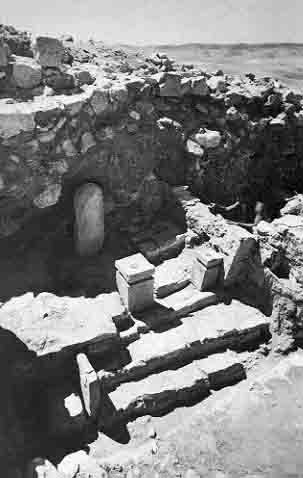Image Details

Yohanan Aharoni
A broad-room temple, with its entrance on one of the long walls (see plan), the Arad temple may reflect early Israelite residential architecture and may represent an authentic Israelite temple form. In contrast, the Solomonic Temple in Jerusalem was a long-room temple built by Phoenician craftsmen and modeled on temples that originated in northwestern Syria in the second millennium B.C.
The shrine of the Arad temple is seen here as it was reconstructed following excavation. It consists of three steps leading to a raised stone platform. Two stone altars for burning incense stand on the top step flanking the entrance to the shrine area proper, separating it from the broad-room at the bottom of the steps. The vertical, light-colored, lozenge-shaped stone stela at the back of the shrine and the darker one to the right, built into the wall, may be massebot—sacred pillars used as cult symbols in early Yahwistic worship. The altars and the massebah on the left are exact replicas of the originals, now in the Israel Museum in Jerusalem.
The Arad temple was rebuilt several times and finally abolished in the late eighth century B.C.—perhaps as part of King Hezekiah”s attempt to stamp out cult sites outside Jerusalem.
The temples at Lachish and Tell es Seba (see plans) are broad-room temples dating to the fourth century B.C. or later—evidence that the Israelite building tradition survived into Hellenistic times. Like the Arad temple, the temples at Lachish and Tell es-Seba were part of a larger complex that featured a central courtyard. Remains of courtyard altars for animal sacrifices were found at Arad and Tell es Seba but not at Lachish.
